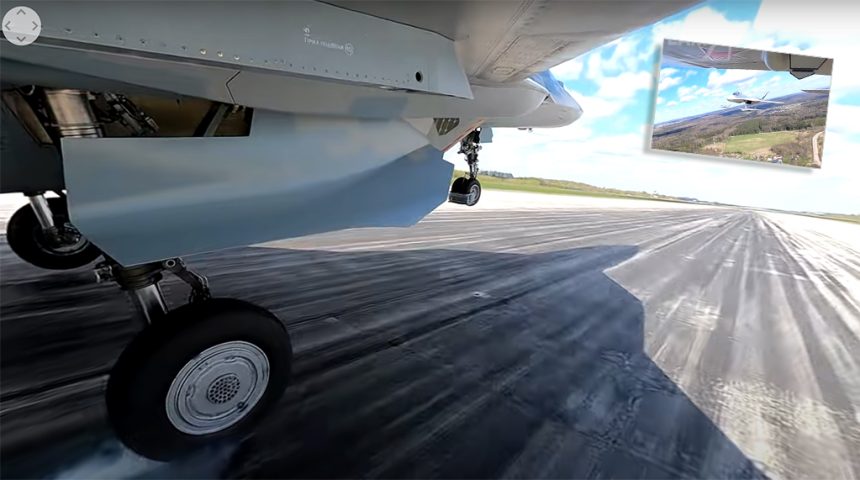From the Felon underwing pylon’s point of view: four Su-57s fly over Moscow.
From Zhukovsky to Moscow and back aboard a Su-57 Felon: this is, more or less, the trip you can “fly” thanks to an interesting 360-degree 5K video filmed from aboard the leader a 4-ship formation of Russian Air Force’s 5th generation aircraft.
The clip, +12 minutes in length, was filmed by A1R FLYCAM with a camera attached to one of the right wing’s pylons: from there, you can observe, virtually, the wing, the pylon itself, the main landing gear and the bay door, the nose gear and also have a look at the position of the rivets/cross tapping screws. Noteworthy are also plenty of holes in the pylons and overall airframe, that can have an impact on the overall radar cross section of the aircraft and, in the end, in its LO (Low Observability).
Anyway, the video also shows the other three Su-57s on the leader’s wing and the constant movements of the flight surfaces as the aircraft, in level flight, carry out the flypast over Moscow, most probably, during the Victory Parade in May.
While it has not annoying soundtrack or post-production music, you can’t hear the peculiar high-pitched ringing engine sound of the Su-57 Felon, generated by the NPO Saturn AL-41F-1, an interim variable-bypass ratio turbofan engine rated at approximately 88.3KN (19,842 lb st) of dry thrust and 142.2kN (31,967 lb st) with afterburning derived from the one used by the Su-35. You can listen to the creepy, howling sound of Russia’s stealth jet in this video we have posted a few weeks ago.
The Russian Air Force has ordered 76 aircraft. Initially, in August 2018, the Ministry of Defense of the Russian Federation and PJSC Sukhoi Company signed a contract for the first two serial Su-57s, T-50S-1 and T-50S-2.
A year later, a follow on contract for 74 other aircraft was inked bringing the total order to 76 Su-57s. The first delivery occurred at the end of 2020 when the first production-model Su-57 fighter, bort number Blue 01, was delivered to the 929th V.P. Chkalov State Flight Test Center in Akhtubinsk to be used to test hypersonic air-launched weapons.
According to Russian Defense Minister Sergei Shoigu 22 Su-57s will be delivered by the end of 2024, while the deliveries (provided that no further aircraft will be added to the order) will be completed by 2028 at a rate of 16 aircraft per year.
This is what we wrote about the Su-57 in an article published last year, when the first series aircraft was delivered:
As you may know, Su-57 is the official designation of the T-50 stealth multirole 5th generation fighter jet that was developed under the PAK-FA program. The requirements envisioned an aircraft capable of supersonic cruise flight with a long combat radius, low radar cross section, super-maneuverability and STOL (Short Take Off and Landing) characteristics, while retaining a substantial ground attack capability. The Su-57 features a substantially reduced Radar Cross Section compared to 4th generation Russian jets, principally in the frontal sector. It seems to be a compromise between reducing the RCS and obtaining high maneuverability and performance while maintaining large weapons bays to accommodate heavy payloads.
The airframe is said to use composite materials up to the 25% of the total weight and Radar Absorbing Materials (RAM). Some of these composite materials had to be sourced from abroad, but now they have been reportedly replaced by “Made in Russia” materials. Another technology that was showcased on the production line is the use of Augmented Reality during a number of processes in the assembly of the Su-57, with some examples showing its usage on the fuselage and the landing gear.
The Sukhoi Su-57 was often criticized by experts for many features that could degrade the low observability such as rivets, weapon doors’, engine nacelles’ and air inlets’ rounded shaping, rough panel’s seamlines, etc. Some of those problems seem to be mitigated in later prototypes and more could have been solved before the serial production. Many of these seem to be missing, or at least reduced, on the aircraft that are now being built serially, as it was visible on T-50S-2 while it was under construction this summer during a visit of the Russian Defense Minister.
[…]
An interesting fact mentioned by the Izvestia newspaper is that the Su-57 may receive “invisibility covers” made of special polymers that are meant to protect the aircraft and its electronics from bad weather when parked in the open outside of hangars, while also making it difficult for foreign intelligence gathering systems to see the outlines of the aircraft in satellite imagery or to detect data about the aircraft’s electronic through SIGINT (SIGnals INTelligence).









